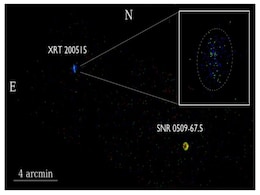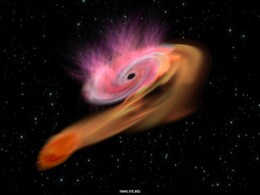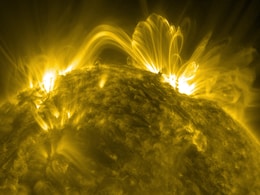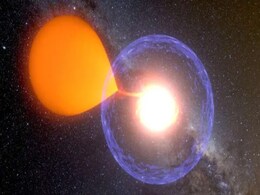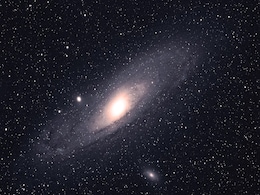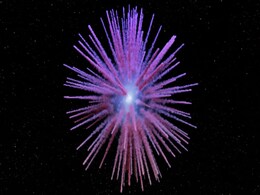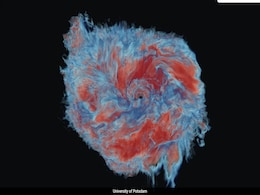Cosmic Explosion
- All
- News
-

Supernova Remnants Found in Oceanic Samples, Scientists Look to Moon
- Wednesday March 26, 2025
- Written by Gadgets 360 Staff
Scientists have identified supernova debris in deep-sea sediments, including a rare plutonium isotope linked to a kilonova. Researchers believe a neutron star collision occurred nearly 10 million years ago, scattering radioactive material across space. To validate this theory, they plan to analyze lunar soil, which remains undisturbed by Earth's ge...
-
 www.gadgets360.com
www.gadgets360.com
-

Unusual X-ray Flash in Large Magellanic Cloud Puzzles Astronomers
- Tuesday February 25, 2025
- Written by Gadgets 360 Staff
A brief yet intense X-ray flash, XRT 200515, was detected in NASA's Chandra telescope data from 2000. The signal, originating from the Large Magellanic Cloud, has left scientists debating its cause. Possible explanations include a neutron star pulling in gas from a companion star or a powerful flare from a distant magnetar. Researchers also specula...
-
 www.gadgets360.com
www.gadgets360.com
-

Unprecedented Cosmic Explosion Discovered: Could This Be The Greatest Space Mystery Ever?
- Tuesday February 11, 2025
- Science | Edited by Nikhil Pandey
A newly detected cosmic explosion, EP240408a, could be the result of a white dwarf's death, creating a high-speed jet. It offers new insights into astrophysics.
-
 www.ndtv.com
www.ndtv.com
-

Hubble Spots Distant Supernova in Gemini, Enhancing Cosmic Distance Studies
- Tuesday February 4, 2025
- Written by Gadgets 360 Staff
The NASA/ESA Hubble Space Telescope has captured a stunning image of SN 2022aajn, a Type Ia supernova in the constellation Gemini. Located 600 million light-years away, the explosion was first detected in November 2022. Type Ia supernovae serve as essential cosmic distance markers due to their predictable brightness. Hubble’s observations, part o...
-
 www.gadgets360.com
www.gadgets360.com
-

Vera C. Rubin Observatory to Detect Millions of Exploding Stars
- Wednesday January 29, 2025
- Written by Gadgets 360 Staff
The Vera C. Rubin Observatory, set to begin its 10-year Legacy Survey of Space and Time (LSST) later this year, will track millions of Type Ia supernovae to advance our understanding of dark energy. These supernovae, resulting from white dwarf stars in binary systems, will be studied in detail to provide crucial data on the universe’s acceleratin...
-
 www.gadgets360.com
www.gadgets360.com
-

Early Supernovas Could Have Created Water in the Universe, Paving the Way for Life 100 Million Years Post-Big Bang
- Friday January 24, 2025
- Written by Gadgets 360 Staff
A recent study suggests that supernova explosions, triggered by the death of early stars, could have created significant amounts of water just 100 million years after the Big Bang. Simulations of these early, massive stars show that their explosive deaths may have resulted in the formation of water molecules within the dense hydrogen and oxygen clo...
-
 www.gadgets360.com
www.gadgets360.com
-

James Webb Space Telescope Detects Supernova From 11.4 Billion Years Ago
- Friday January 17, 2025
- Written by Gadgets 360 Staff
Astronomers using the James Webb Space Telescope (JWST) have identified AT 2023adsv, a supernova that occurred 11.4 billion years ago. This stellar explosion, from a star 20 times the size of the Sun, offers a glimpse into the early universe's unique stellar evolution. Part of the JWST Advanced Deep Extragalactic Survey, the event highlights how th...
-
 www.gadgets360.com
www.gadgets360.com
-

Astronomers Spot New Cosmic Explosions 100 Times Brighter Than the Sun
- Wednesday December 25, 2024
- Written by Gadgets 360 Staff
Astronomers have discovered a new class of cosmic explosions, known as 'millinovas,' which are 100 times brighter than the Sun. These events, first identified in 2023, were observed in the Large and Small Magellanic Clouds, two satellite galaxies of the Milky Way. The millinovas are thought to occur when white dwarfs feed off a companion star, prod...
-
 www.gadgets360.com
www.gadgets360.com
-

ISRO’s AstroSat Observes First-Ever Nuclear Explosion in Andromeda Galaxy
- Tuesday December 10, 2024
- Written by Gadgets 360 Staff
Using the Ultraviolet Imaging Telescope (UVIT) aboard ISRO’s AstroSat, scientists have identified far-ultraviolet emissions from 42 novae in the Andromeda Galaxy. This marks the first detection of such emissions during their outbursts, offering new insights into the processes of stellar explosions. Four of these novae were observed in real-time a...
-
 www.gadgets360.com
www.gadgets360.com
-

Supernova SN 1181 Reveals Rare “Zombie Star” in Pa 30 Nebula
- Monday October 28, 2024
- Written by Gadgets 360 Staff
A supernova recorded in 1181, known as SN 1181, has been linked to the Pa 30 nebula, revealing a rare “zombie star.” Advanced 3D imaging from the Keck Observatory has shown unusual filaments expanding from this star, marking it as a unique case in supernova studies. This zombie star survived a thermonuclear explosion on a white dwarf, challengi...
-
 www.gadgets360.com
www.gadgets360.com
-

Supermassive Black Hole Jets Spark Increased Nova Explosions, Hubble Discovers
- Thursday October 3, 2024
- Written by Gadgets 360 Staff
Recent findings from the Hubble Space Telescope reveal that supermassive black hole jets may be responsible for an increase in nova explosions in nearby double-star systems. This unexpected connection indicates that the energetic jets emitted by black holes can influence the surrounding stellar environment, leading to heightened activity in nova er...
-
 www.gadgets360.com
www.gadgets360.com
-

"Once-In-A-Lifetime" Cosmic Explosion Will Be Visible From Earth, Says NASA
- Thursday June 20, 2024
- Science | Edited by Ritu Singh
The "Blaze Star," which is a binary system in the Northern Crown about 3,000 light years from Earth, is comprised of a white dwarf, an Earth-sized remnant of a dead star with a mass comparable to the sun.
-
 www.ndtv.com
www.ndtv.com
-

Supernova Remnants Found in Oceanic Samples, Scientists Look to Moon
- Wednesday March 26, 2025
- Written by Gadgets 360 Staff
Scientists have identified supernova debris in deep-sea sediments, including a rare plutonium isotope linked to a kilonova. Researchers believe a neutron star collision occurred nearly 10 million years ago, scattering radioactive material across space. To validate this theory, they plan to analyze lunar soil, which remains undisturbed by Earth's ge...
-
 www.gadgets360.com
www.gadgets360.com
-

Unusual X-ray Flash in Large Magellanic Cloud Puzzles Astronomers
- Tuesday February 25, 2025
- Written by Gadgets 360 Staff
A brief yet intense X-ray flash, XRT 200515, was detected in NASA's Chandra telescope data from 2000. The signal, originating from the Large Magellanic Cloud, has left scientists debating its cause. Possible explanations include a neutron star pulling in gas from a companion star or a powerful flare from a distant magnetar. Researchers also specula...
-
 www.gadgets360.com
www.gadgets360.com
-

Unprecedented Cosmic Explosion Discovered: Could This Be The Greatest Space Mystery Ever?
- Tuesday February 11, 2025
- Science | Edited by Nikhil Pandey
A newly detected cosmic explosion, EP240408a, could be the result of a white dwarf's death, creating a high-speed jet. It offers new insights into astrophysics.
-
 www.ndtv.com
www.ndtv.com
-

Hubble Spots Distant Supernova in Gemini, Enhancing Cosmic Distance Studies
- Tuesday February 4, 2025
- Written by Gadgets 360 Staff
The NASA/ESA Hubble Space Telescope has captured a stunning image of SN 2022aajn, a Type Ia supernova in the constellation Gemini. Located 600 million light-years away, the explosion was first detected in November 2022. Type Ia supernovae serve as essential cosmic distance markers due to their predictable brightness. Hubble’s observations, part o...
-
 www.gadgets360.com
www.gadgets360.com
-

Vera C. Rubin Observatory to Detect Millions of Exploding Stars
- Wednesday January 29, 2025
- Written by Gadgets 360 Staff
The Vera C. Rubin Observatory, set to begin its 10-year Legacy Survey of Space and Time (LSST) later this year, will track millions of Type Ia supernovae to advance our understanding of dark energy. These supernovae, resulting from white dwarf stars in binary systems, will be studied in detail to provide crucial data on the universe’s acceleratin...
-
 www.gadgets360.com
www.gadgets360.com
-

Early Supernovas Could Have Created Water in the Universe, Paving the Way for Life 100 Million Years Post-Big Bang
- Friday January 24, 2025
- Written by Gadgets 360 Staff
A recent study suggests that supernova explosions, triggered by the death of early stars, could have created significant amounts of water just 100 million years after the Big Bang. Simulations of these early, massive stars show that their explosive deaths may have resulted in the formation of water molecules within the dense hydrogen and oxygen clo...
-
 www.gadgets360.com
www.gadgets360.com
-

James Webb Space Telescope Detects Supernova From 11.4 Billion Years Ago
- Friday January 17, 2025
- Written by Gadgets 360 Staff
Astronomers using the James Webb Space Telescope (JWST) have identified AT 2023adsv, a supernova that occurred 11.4 billion years ago. This stellar explosion, from a star 20 times the size of the Sun, offers a glimpse into the early universe's unique stellar evolution. Part of the JWST Advanced Deep Extragalactic Survey, the event highlights how th...
-
 www.gadgets360.com
www.gadgets360.com
-

Astronomers Spot New Cosmic Explosions 100 Times Brighter Than the Sun
- Wednesday December 25, 2024
- Written by Gadgets 360 Staff
Astronomers have discovered a new class of cosmic explosions, known as 'millinovas,' which are 100 times brighter than the Sun. These events, first identified in 2023, were observed in the Large and Small Magellanic Clouds, two satellite galaxies of the Milky Way. The millinovas are thought to occur when white dwarfs feed off a companion star, prod...
-
 www.gadgets360.com
www.gadgets360.com
-

ISRO’s AstroSat Observes First-Ever Nuclear Explosion in Andromeda Galaxy
- Tuesday December 10, 2024
- Written by Gadgets 360 Staff
Using the Ultraviolet Imaging Telescope (UVIT) aboard ISRO’s AstroSat, scientists have identified far-ultraviolet emissions from 42 novae in the Andromeda Galaxy. This marks the first detection of such emissions during their outbursts, offering new insights into the processes of stellar explosions. Four of these novae were observed in real-time a...
-
 www.gadgets360.com
www.gadgets360.com
-

Supernova SN 1181 Reveals Rare “Zombie Star” in Pa 30 Nebula
- Monday October 28, 2024
- Written by Gadgets 360 Staff
A supernova recorded in 1181, known as SN 1181, has been linked to the Pa 30 nebula, revealing a rare “zombie star.” Advanced 3D imaging from the Keck Observatory has shown unusual filaments expanding from this star, marking it as a unique case in supernova studies. This zombie star survived a thermonuclear explosion on a white dwarf, challengi...
-
 www.gadgets360.com
www.gadgets360.com
-

Supermassive Black Hole Jets Spark Increased Nova Explosions, Hubble Discovers
- Thursday October 3, 2024
- Written by Gadgets 360 Staff
Recent findings from the Hubble Space Telescope reveal that supermassive black hole jets may be responsible for an increase in nova explosions in nearby double-star systems. This unexpected connection indicates that the energetic jets emitted by black holes can influence the surrounding stellar environment, leading to heightened activity in nova er...
-
 www.gadgets360.com
www.gadgets360.com
-

"Once-In-A-Lifetime" Cosmic Explosion Will Be Visible From Earth, Says NASA
- Thursday June 20, 2024
- Science | Edited by Ritu Singh
The "Blaze Star," which is a binary system in the Northern Crown about 3,000 light years from Earth, is comprised of a white dwarf, an Earth-sized remnant of a dead star with a mass comparable to the sun.
-
 www.ndtv.com
www.ndtv.com


